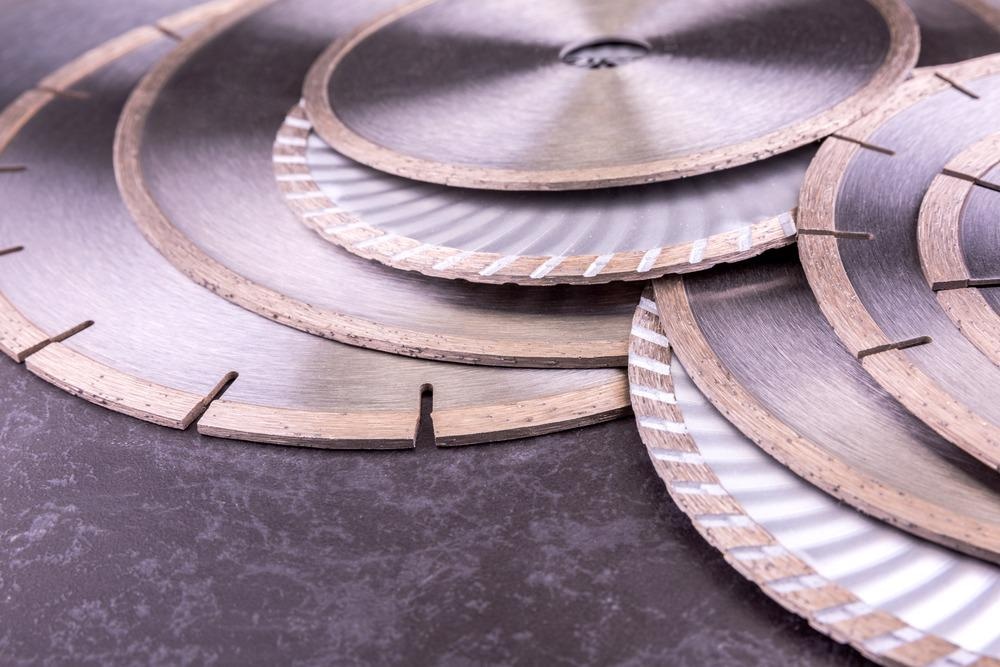This article explores the use of diamond blades, from cutting hard building materials to semiconductor manufacturing.

Image Credit: Massima/Shutterstock.com
Diamond saw blades are created by gluing diamond grit towards the blade's steel body, resulting in a harder, more robust blade capable of cutting even the hardest materials.
Diamond Blades and Building Materials
Diamond is one of the hardest naturally occurring materials known to man. In a diamond blade, the synthetic diamond materials are mixed with other materials such as iron or steel to form the right blade with outstanding diamond segments along the cutting edge.
Diamond blades are generally used for cutting hard materials. Cutting is a fundamental technical procedure in the manufacture of items depending on the technical needs and function of the formed part.
The produced blade is suitable for cutting a wide variety of materials, including concrete, granite, ceramic tile, asphalt, bricks, and other hard stone, as well as nearly any other type of building material.
Advantages of Using Diamond Blades for Building Materials
When applied to suitable materials, diamond blades are extremely sturdy and have an outstanding lifespan. Due to the nature of these blades and the variety of choices to suit the different materials that need to be cut, users can expect blades to last a longer period of time when a suitable blade is picked for a certain material.
Diamond blades cut swiftly, which expedites the cutting process and reduces noise-related concerns in the workplace. They will not cut in complete silence, but employing a high-quality and material-appropriate diamond blade will significantly reduce the amount of noise generated; reduced resistance equals reduced noise.
Due to the simplicity with which these blades cut, they generate less heat during operation due to less friction. With the proper blade and the proper usage of a cooling system, little to no heat is generated. The result of these qualities is a comfortable and efficient cutting procedure.
Limitations of Diamond Blades for Building Materials
The disadvantages of diamond include its low thermal stability, chemical reactivity with iron group elements, and carbonization at 700 to 800 degrees celsius, which normally does not apply to steel production.
The same is true when cutting nickel-based alloys. Generally, researchers do not advocate using diamond cutting tools made out of high melting temperature metals or alloys. Additionally, diamond tool grinding is time-consuming and costly.
Diamond Blades in Semiconductor Manufacturing
The semiconductor manufacturing method using diamond blades has already improved wafering processes and resulted in significant cost savings in device fabrication. Additional gains in wafer productivity and quality may be made by adopting a systems-based approach to the slicing procedure.
Additional advancements, such as stainless-steel diamond, wheel cores, and increased cutting speeds, have resulted in considerable cost savings for both the materials processor and the device maker.
Today, automated factories with high throughput for workpieces up to 400 mm in blade diameter are available. Previous advancements were concentrated on the slicing machine and cutting wheels, however, slicing involves a plethora of other factors including wheel attachments, crystal mounting for slicing, coolant selection, handling, and worker skill and competency. Controlling all of these factors precisely may result in even more improvements and cost savings throughout the wafering procedure.
Problems of Diamond Blades in Semiconductor Manufacturing
Slicing concerns are becoming more challenging nowadays as bigger and longer crystals are produced. While bigger, longer crystals increase the processor's efficiency, they introduce complications since the current slicing machinery is not built to handle such huge workpieces.
Additionally, larger dimensions result in more waste when rejections occur. With new semiconductor materials costing up to 20 to 30 times the price of silicon and germanium, significant kerf losses and significant reject rates are too costly. The geometry and surface polish of a wafer dictates its quality.
Solutions to Improve Diamond Blades in Semiconductor Manufacturing
After mounting the blade upon the machine, it is tested for concentricity. Friction and heat may release strains in the core material during operation, allowing tension to relax. As a result, machine tensioning is a frequent procedure.
The diamond wheel head should be dynamically balanced, with clean, parallel, and smooth clamping surfaces. The diamond materials must be carefully chosen for their particle size, strength, and shape. Lastly, the diamond blade must be handled with delicacy. It must be installed, tensioned, polished, and operated appropriately.
All of these elements contribute to the ultimate outcome, which is the efficient and precise slicing of semiconductor wafers to precise tolerances with the least amount of kerf loss and product damage possible.
References and Further Reading
Dobrescu, T., et al. (2013). Improving the slicing process characteristic parameters. Proceedings in Manufacturing Systems. https://www.researchgate.net/publication/350312773_IMPROVING_THE_SLICING_PROCESS_CHARACTERISTIC_PARAMETERS
Li, K., et al. (2019). Analysis of the Dynamic Diameter of Superthin Diamond Blades in the High Speed and Precison Dicing Process. International Journal of Precision Engineering and Manufacturing volume 20 pages1071–1081. https://link.springer.com/article/10.1007/s12541-019-00128-7
Disclaimer: The views expressed here are those of the author expressed in their private capacity and do not necessarily represent the views of AZoM.com Limited T/A AZoNetwork the owner and operator of this website. This disclaimer forms part of the Terms and conditions of use of this website.